Grievance Procedure Letter
[Your Name]
[Your Address]
[City, State, Zip Code]
[Email Address]
[Phone Number]
[Date]
[Recipient's Name]
[Recipient's Title]
[Company/Organization Name]
[Address]
[City, State, Zip Code]
Dear [Recipient's Name],
Subject: Formal Grievance Procedure
I am writing to formally express my concerns and initiate the grievance procedure in accordance with [Company/Organization Name]'s established grievance policy, as outlined in the [Employee Handbook/Policy Manual/Contract, etc.]. I believe it is important to address this matter through the proper channels to ensure a fair and transparent resolution.
[Provide a brief description of the grievance, including relevant dates, incidents, and individuals involved. Be factual and concise.]
I have attempted to address this matter informally, but unfortunately, my concerns have not been adequately addressed or resolved. In light of this, I am now formally invoking the grievance procedure to seek a resolution.
As outlined in the company's policy, I request the following steps be taken to address my grievance:
1. **Submission of Grievance**: This letter serves as the formal submission of my grievance. I request that my concerns be documented and entered into the formal grievance process.
2. **Grievance Meeting**: I kindly request a meeting to discuss my grievance with the appropriate parties. I am open to a mutually agreed-upon date and time for this meeting. During the meeting, I would appreciate the opportunity to present my concerns and provide any supporting evidence.
3. **Investigation and Resolution**: Following the grievance meeting, I request a thorough and impartial investigation into the matter. I trust that all parties involved will be given an opportunity to provide their perspectives and any relevant information.
4. **Communication of Findings**: Upon completion of the investigation, I expect to be informed of the findings and any proposed resolution(s) in a timely manner.
5. **Appeal Process**: If I am dissatisfied with the resolution proposed, I request information about the appeal process, as outlined in the company's grievance policy.
I firmly believe in the importance of a positive and respectful work environment, and I am committed to working towards a resolution that is fair and beneficial for all parties involved.
I appreciate your attention to this matter and look forward to a prompt and equitable resolution. Please acknowledge receipt of this letter and provide information about the next steps in the grievance procedure.
Thank you for your understanding and cooperation.
Sincerely,
[Your Signature]
[Your Typed Name]
Enclosure: [List any supporting documents you may be including]
CC: [List any relevant parties you wish to copy on the letter]
Formal Grievance Procedure Letter
Subject: Submission of Grievance
Dear [HR Manager/Supervisor],
I am writing to formally raise a grievance regarding [specific issue]. Despite previous discussions, the matter has not been resolved satisfactorily, and I believe it is necessary to follow the formal grievance procedure.
The details of the issue are as follows: [Provide clear, factual description including dates, individuals involved, and supporting evidence]. I request that this grievance be addressed in accordance with company policies, and I am available for a meeting to discuss this further.
I trust that this matter will be handled with confidentiality and prompt attention.
Sincerely,
[Employee Name]
[Department]
[Contact Information]
Informal Grievance Email
Subject: Concern Regarding Workplace Issue
Hello [Manager Name],
I wanted to bring to your attention a concern regarding [describe issue briefly]. I hope we can address this matter amicably and find a solution.
Please let me know a convenient time to discuss this in detail. I appreciate your support and guidance in resolving this matter.
Thank you,
[Employee Name]
Grievance Letter About Harassment
Subject: Formal Grievance Concerning Harassment
Dear [HR Manager],
I am writing to formally raise a grievance concerning repeated instances of harassment by [person involved]. This behavior has created a hostile work environment and affected my wellbeing and productivity.
Details of the incidents include [dates, locations, specific actions]. I request that this grievance be investigated following the company’s grievance procedure and appropriate action be taken.
I am willing to cooperate fully with any investigation and provide further evidence if needed.
Sincerely,
[Employee Name]
[Department]
Grievance Letter About Unfair Treatment
Subject: Formal Grievance Regarding Unfair Treatment
Dear [Supervisor/HR],
I am submitting a formal grievance concerning unfair treatment in relation to [describe the situation, e.g., promotions, workload distribution]. Despite raising this informally, the matter has not been addressed.
I request a meeting to discuss this issue formally and seek a fair resolution in line with company policy. I have attached supporting documentation for your review.
Sincerely,
[Employee Name]
[Department]
Provisional Grievance Letter
Subject: Preliminary Grievance Submission
Dear [HR],
I am submitting this letter to notify you of a concern regarding [brief description of issue]. This is a provisional submission to formally document my concern while I gather further information.
I request acknowledgment of this grievance and guidance on the next steps as per the grievance procedure.
Thank you for your attention.
Best regards,
[Employee Name]
Serious Tone Grievance Letter
Subject: Urgent Grievance Notification
Dear [HR Manager],
I am writing to formally report a serious concern regarding [describe issue]. This matter has significantly impacted my work performance and wellbeing.
I request an immediate review of this grievance and appropriate corrective measures. Confidentiality and prompt action are requested.
Sincerely,
[Employee Name]
[Department]
Quick and Simple Grievance Message
Subject: Grievance Notification
Hi [Manager Name],
I am submitting a grievance concerning [brief description]. I would appreciate a meeting to discuss this further and find a resolution.
Thanks,
[Employee Name]
Heartfelt Grievance Letter
Subject: Grievance Regarding Workplace Concern
Dear [HR Manager],
I feel compelled to raise a grievance regarding [issue] that has been affecting me personally and professionally. Despite attempts to resolve this informally, the situation remains unresolved.
I hope this letter conveys the seriousness of my concern and request that it is addressed promptly in accordance with company procedures. I am ready to discuss and provide any necessary details.
Thank you for your understanding.
Sincerely,
[Employee Name]
What is a Grievance Procedure Letter and Why It Is Important
- A formal communication by an employee to report a workplace concern, complaint, or dispute.
- Purpose: Ensure the issue is documented and handled in accordance with company policy.
- Protects employee rights and maintains workplace fairness.
- Provides a structured process for resolution.
Who Should Send a Grievance Procedure Letter
- Any employee experiencing a workplace issue affecting their rights, treatment, or wellbeing.
- Can be submitted individually or jointly with colleagues if multiple parties are affected.
- Typically directed to HR, a supervisor, or a designated grievance officer.
Whom the Grievance Letter Should Be Addressed To
- Human Resources department.
- Direct manager or supervisor if company policy allows.
- Designated grievance committee or officer for formal procedures.
- For serious concerns, potentially senior management depending on escalation protocols.
When to Send a Grievance Procedure Letter
- After informal attempts to resolve the issue have failed.
- When workplace behavior or policies negatively affect the employee.
- In cases of harassment, discrimination, bullying, unfair treatment, or contractual breaches.
- Immediately after serious incidents to ensure timely documentation.
How to Write and Submit a Grievance Procedure Letter
- Clearly identify the issue, including dates, locations, and individuals involved.
- Use factual, concise, and professional language.
- Attach evidence if applicable (emails, reports, records).
- Request acknowledgment and follow-up in line with company policy.
- Maintain copies for personal records.
- Send via email or printed letter, depending on procedure requirements.
Requirements and Prerequisites Before Sending
- Familiarity with the company’s grievance procedure policy.
- Documentation of the incident(s) or concern.
- Understanding of escalation steps and timelines.
- Maintaining professional and factual tone; avoid emotional exaggeration.
Formatting Guidelines for a Grievance Procedure Letter
- Length: 1-2 pages; concise yet detailed.
- Tone: Professional, serious, and factual.
- Structure:
- Subject line indicating grievance
- Greeting
- Clear description of issue
- Supporting details or evidence
- Request for action or meeting
- Closing statement
- Signature
- Avoid informal language, jokes, or threats.
Tricks and Tips for Effective Grievance Letters
- Keep a factual, chronological record of events.
- Include specific examples and evidence.
- Be polite but firm; avoid aggressive language.
- Follow company policy exactly to ensure procedural compliance.
- Request confirmation of receipt.
Common Mistakes to Avoid
- Sending vague or emotionally charged letters.
- Omitting key details or evidence.
- Failing to follow internal grievance procedure.
- Ignoring confidentiality requirements.
- Delaying submission unnecessarily.
After Sending a Grievance Letter
- Confirm receipt with HR or the designated recipient.
- Be prepared for meetings or investigations.
- Keep detailed notes of all communications related to the grievance.
- Maintain professional conduct throughout the resolution process.
Pros and Cons of Sending a Grievance Procedure Letter
Pros:
- Ensures issues are formally documented.
- Promotes fair treatment and accountability.
- Triggers official procedures for resolution.
Cons:
- May create tension with colleagues or supervisors.
- Could take time to resolve, causing stress.
- Requires careful attention to policy and procedure to avoid rejection.
Elements and Structure of a Grievance Procedure Letter
- Subject: Clearly indicate grievance.
- Introduction: State purpose of letter.
- Details of the Issue: Chronological, factual description.
- Supporting Evidence: Attach or reference documents.
- Request for Action: Specify desired outcome or meeting.
- Closing: Polite conclusion requesting follow-up.
- Signature: Employee name, department, and contact information.
Does a Grievance Procedure Letter Require Authorization?
- No external attestation is needed.
- Should be submitted according to company policy.
- Official letters may require acknowledgment by HR or designated officer.
- Signed and dated by the employee for record-keeping purposes.
How Many Grievance Letters Should Be Sent
- Typically, only one formal grievance letter per issue is needed.
- Follow-up letters may be sent if no acknowledgment or response is received.
- Additional letters may be necessary for escalation to higher management or committees.
Compare and Contrast Grievance Letters with Other Complaint Methods
- Grievance Letter vs Informal Email: Letter is formal, documented; email may be preliminary or informal.
- Grievance Letter vs Verbal Complaint: Written letter ensures record, verifiable evidence; verbal complaints can be less effective.
- Alternatives: Online HR portals, official forms, or grievance meetings can complement or initiate the process.
FAQ About Grievance Procedure Letters
-
Q: Can I submit anonymously?
A: Typically no; your identity is required for investigation. -
Q: How long does resolution take?
A: Depends on company policy; usually defined in the grievance procedure. -
Q: Can I escalate if not satisfied?
A: Yes, follow the escalation path defined in company policy. -
Q: Should I involve a union or representative?
A: If applicable, union involvement may be recommended. -
Q: Is confidentiality guaranteed?
A: Companies are obligated to handle grievances confidentially within the limits of the investigation.

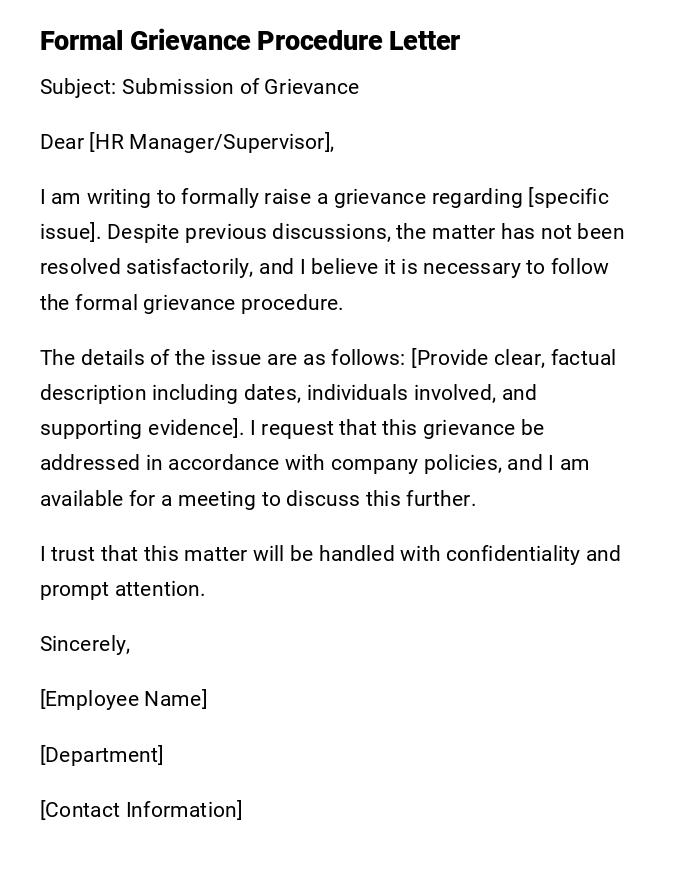
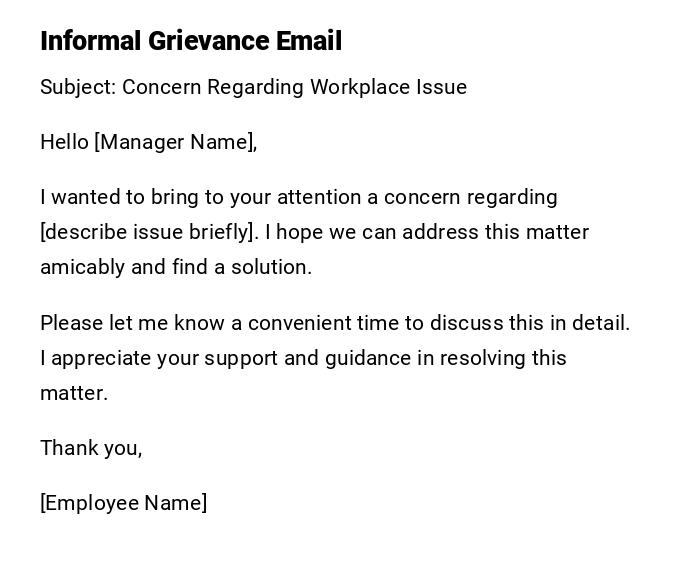
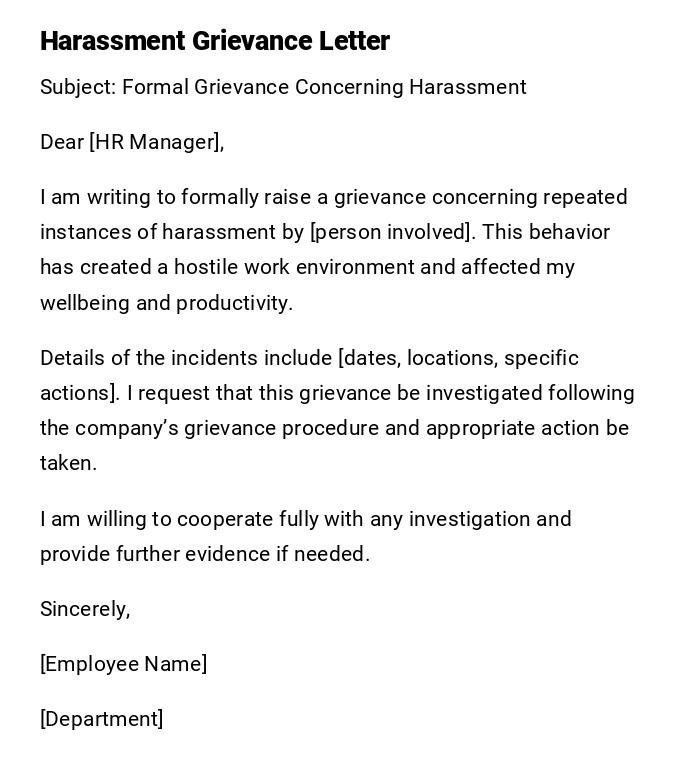
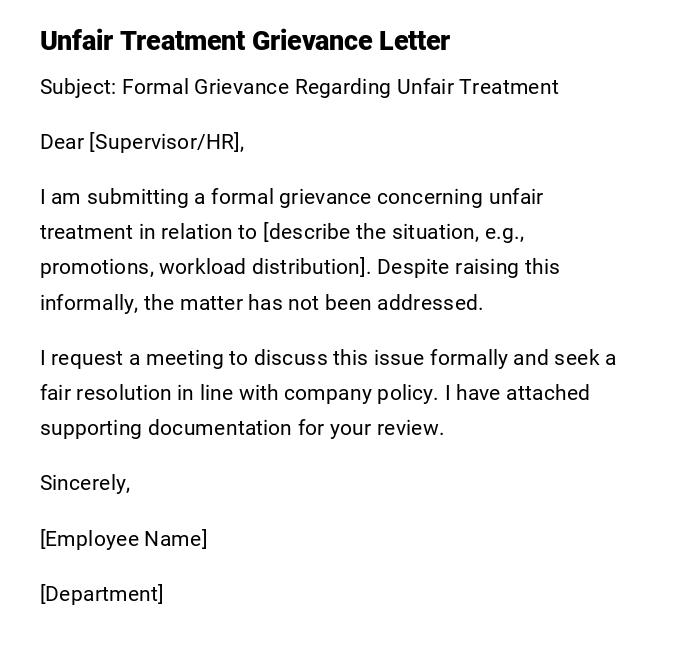
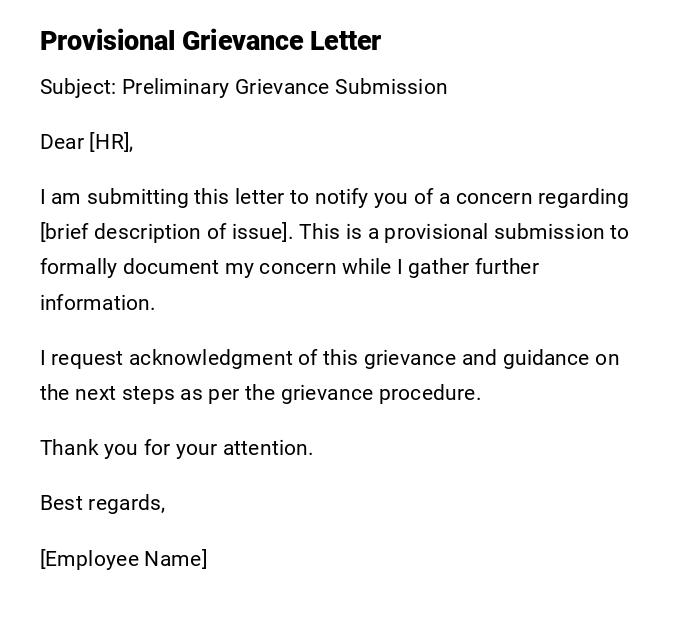
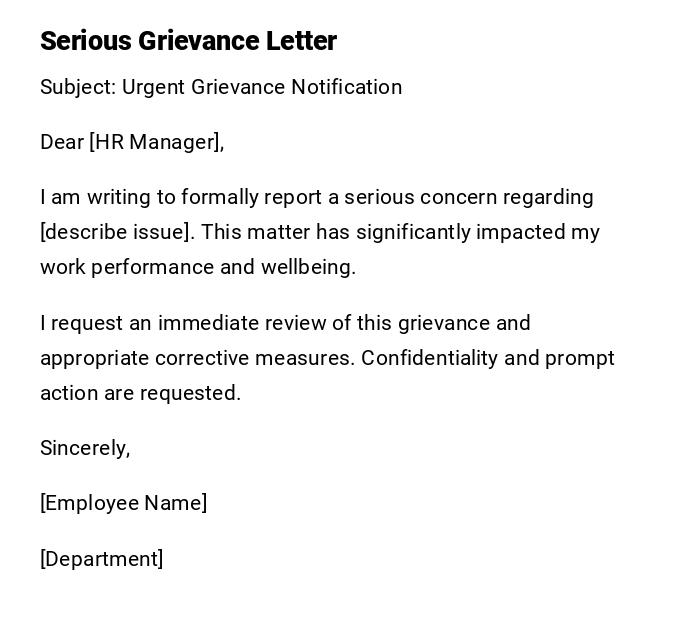
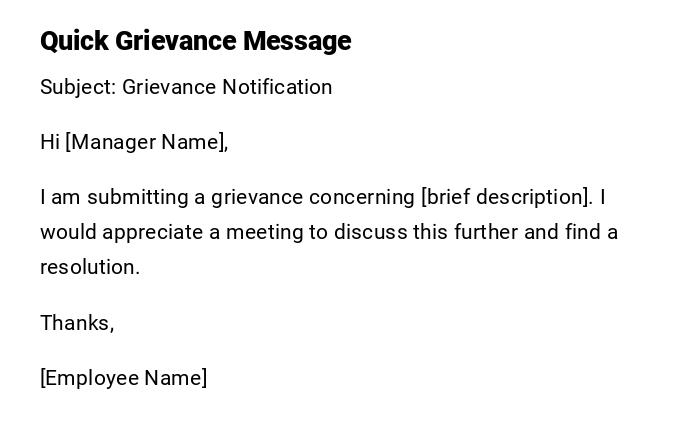
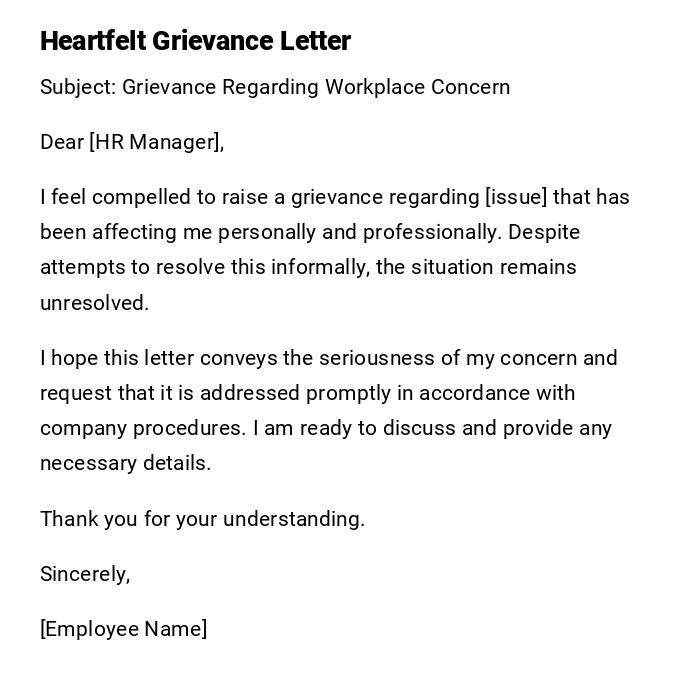

 Download Word Doc
Download Word Doc
 Download PDF
Download PDF